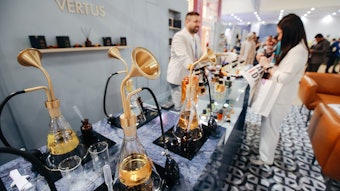A report entitled “Prepubertal Gynecomastia Linked to Lavender and Tea Tree Oils” appeared in the February 1, 2007 New England Journal of Medicine (Henley et al. 2007). The authors “investigated possible causes of gynecomastia in three prepubertal boys who were otherwise healthy and had normal serum concentrations of endogenous steroids. In all three boys, gynecomastia coincided with the topical application of products that contained lavender and tea tree oils. Gynecomastia resolved in each patient shortly after the use of products containing these oils was discontinued. Furthermore, studies in human cell lines indicated that the two oils had estrogenic and antiandrogenic activities. We conclude that repeated topical exposure to lavender and tea tree oils probably caused prepubertal gynecomastia in these boys.” To put the context of this paper into perspective it is worthwhile reviewing some information pertinent to this report.
Conclusions Drawn from the New England Journal of Medicine Report
Question 1: Were the chemical compositions of the oils of lavender and tea tree determined and were the oils pure, natural and genuine?
Answer: No analyses were performed or reported, so the purity and genuineness of the oils used in the study remain unknown.
Question 2: Was the in vitro test using human breast cancer (MCF-7) cells a conclusive study to draw the above conclusion?
Answer: No. A single in vitro test and a case study does not warrant the quantum leap to the conclusion drawn. Prior to drawing such a conclusion (albeit “probably”—which did not appear in the somewhat sensational report title) a battery of in vitro tests combined with in vivo studies should be performed.
Question 3: Do lavender oil and tea tree oil possess estrogenic activity and what are the implications of such activity?
Answer: It is possible that a conclusion from the test run by Henley et al. is that both oils could indicate estrogenic activity; however, the biological significance of this is unknown.
Question 4: Does the reaction of either lavender oil or tea tree oil with an estrogen receptor mean that it reacts in in vivo tests the same way?
Answer: Translation of an in vitro test or tests to in vivo studies with the objective of obtaining conclusive evidence for estrogenic activity in humans requires a full understanding of the mechanisms associated with the activity, which we do not have.
Question 5: Have the authors addressed the necessary parameters associated with topical application of a foreign material in the case study?
Answer: The details associated with the use of lavender and tea tree oil by the three prepubertal boys showed that they were using personal care products such as a lavender oil containing healing balm, a lavender and tea tree oil containing styling gel and shampoo and a lavender scented soap and skin lotion. No analyses of the levels of oils were made in the products nor were the other ingredients noted so the conclusion that lavender and tea tree oil were the ingredients responsible for gynecomastia was not really proved. Also, no parameters associated with the topical application of the personal care products were measured or determined.
Question 6: As Henley et al. (2007) used breast cancer cells in their estrogenic screening test, is this directly translatable to the observed gynecomastia in the prepubertal boys?
Answer: Although when performing in vitro screening tests on mammary cells it is normal to use cancer cells, the observed changes in the cells and estrogenic activity determination may or may not be directly translatable to prepubertal boys because the cells used in the study were breast cancer cell, presumably not found in the prepubertal boys.
Question 7: Is it possible that phthalate-contaminated oils or personal care products could be responsible for the observed gynecomastia?
Answer: A review of the literature associated with estrogenic activity of phthalates and/or premature breast development (thelarche) revealed that premature breast development in very young girls (< 8 years) is known particularly in Puerto Rico (Bongiovanni 1983). Colón et al. (2000) found that young Puerto Rican girls that had premature breast development had significantly high levels of dimethyl, diethyl, dibutyl and di-2-ethylhexyl phthalates in their serum as well as the metabolite mono-2-ethylhexyl phthalate. Furthermore, the authors showed that the phthalates were endocrine-disrupting chemicals.
Moore (2000) examined the published data on the estrogenic potential oil phthalate esters and concluded that the in vitro studies performed were not relevant to humans or the environment. A note in the report by Moore did show that MCF-7 cells (the same cells used by Henley et al. 2007) did have the capacity to metabolize phthalate esters.
Okubo et al. (2003) found that, of the commonly used and encountered phthalates, some were found in an in vitro to possess estrogenic activity, while others were found to be anti-estrogenic. This finding was supported by Takeuchi et al. (2005). McKee (2004) criticized the findings of Colón et al. (2000) noting that there might well have been an artificial contamination of the serum samples with vinyl laboratory equipment. He also stated that as phthalates are metabolized in the human body rapidly and in vitro studies of the mono-phthalate metabolites are not active under in vitro conditions, he doubted the validity of the Colón et al. (2000) study.
An excellent review of the effects of phthalates on human health has been published (Hauser and Calafat 2005). In this review, the authors cite a study by Zacharewski et al. (1998) in which the phthalates were not found to be estrogenic under either in vitro conditions or in in vivo studies. As a result, it is highly unlikely that phthalates are responsible for any of the changes and activities observed and determined.
Question 8: Do many plant isolates possess estrogenic activity and what is their effect on humans?
Answer: The reports on the existence of phytoestrogens, which can positively react with estrogen receptors are manifold, the most commonly known being the studies on soy and its isolates; however, whether this estrogenic activity translates in vivo in a positive or negative way in humans has not been irrevocably concluded.
Question 9: Could (-)-linalool, (-)-linalyl acetate and (+)-terpinen-4-ol possess estrogenic activity according to the test methodology used?
Answer: Yes. It is quite possible that the activities of the oils were weakly estrogen receptor-dependent according to the tests used. This implies that the major constituents may also possess weak estrogenic activity. Unfortunately, the authors treated the oils as single components rather than complex mixtures of chiral and non-chiral constituents.
Question 10: Should the study affect the use of lavender oil or tea tree oil in perfumery, cosmetic or personal care products?
Answer: No, as the conclusions from the study are not substantive based on the tests performed.
References
A.M. Bongiovanni, An epidemic of premature thelarche in Puerto Rico. J. Pediatr., 103, 245–246 (1983).
T.R. Zacharewski, M.D. Meek and J.H. Clemons, Examination of the in vitro and in vivo estrogenic activities of eight commercial phthalate esters. Toxicol. Sci., 46, 283–293 (1998).
I. Colón, D. Caro, C.J. Bourdony and O. Rosario, Identification of phthalate esters in the serum of young Puerto Rican girls with premature breast development. Environ. Health Perspect., 108, 895–890 (2000).
N.P. Moore, The oestrogenic potential of the phthalate esters. Reprod. Toxicol., 14, 183–192 (2000).
T. Okubo, T. Suzuki, Y. Yokoyama, K. Kano and I. Kano, Estimation of estrogenic and anti-estrogenic activities in some phthalate diesters and monoesters by MCF-7 cell proliferation assay in vitro. Biol. Pharm. Bull., 26, 1219–1224 (2003).
R.H. McKee, Phthalate exposure and early thelarche. Environ. Health Perspect., 112, A541–543 (2004).
R. Hauser and A.M. Calafat, Phthalates and human health. Occup. Environ. Med., 62, 806–818 (2005).
S. Takeuchi, M. Iida, S. Kobayashi, K. Jin, T. Matsuda and H. Kojima, Differential effects of phthalate esters on transcriptional activities via human estrogen receptors alpha and beta, and androgen receptor. Toxicol., 210, 223–233 (2005).
D.V. Henley, N. Lipson, K.S. Korach and C.A. Bloch, Prepubertal gynecomastia linked to lavender and tea tree oils. New Engl. J. Med., 365, 479–485 (2007).










